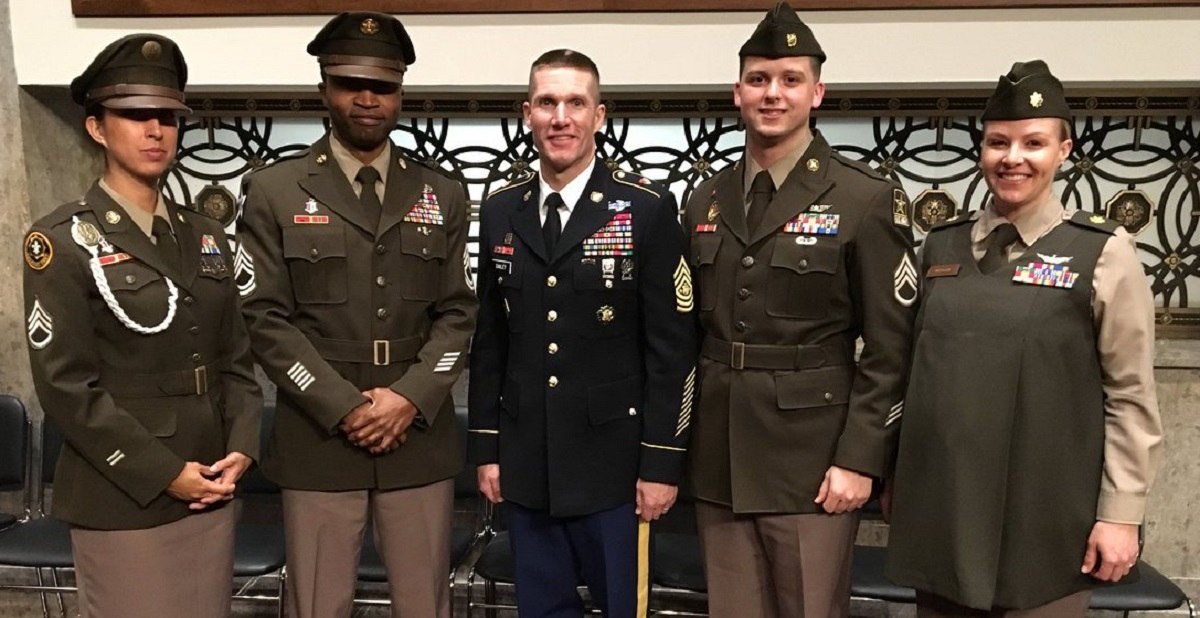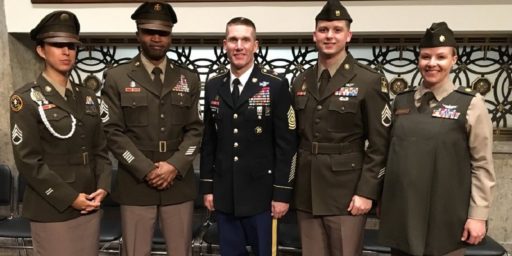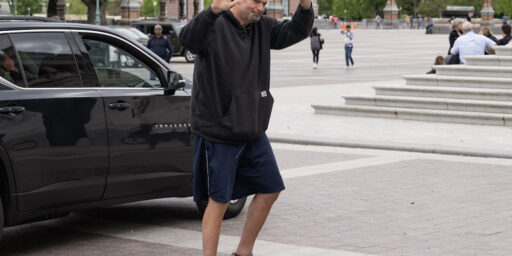The Slow Rollout of Pinks and Greens
The Army is finally getting its World War II uniforms, one base at a time.

The United States Army has been creeping towards another change in its “service” uniform for years. Now, the so-called “Army Green” uniform that everyone calls “Pinks and Greens” even though it’s brown is being issued to basic training soldiers on one base.
Military.com (“Fort Sill Just Became the First Training Base to Get the New Army Greens Uniform“):
Army privates at Fort Sill, Oklahoma are the lucky first trainees to receive the service’s new World War II-style dress uniform.
This month, about 200 soldiers going through Basic Combat Training in the 434th Field Artillery Brigade at Sill were issued a full Army Green Service Uniform, a modern version of the iconic uniform worn by Gen. Dwight Eisenhower, supreme allied commander in World War II Europe.
“We’re the first Army training base to get the Army Green Service Uniform, which is pretty neat for obviously these soldiers in training and obviously for the leadership,” Command Sgt. Major Donald Harding, the senior enlisted leader of the 434th, said an Army news release.
Army recruiters and drill sergeants were the first to begin receiving the new AGSU because the two groups are considered the face of the Army, officials have said. Soldiers attending the Army’s Recruiting and Retention College at Fort Knox, Kentucky, started to receive their Army Greens in July in an effort to ensure all recruiters are issued the uniform by early 2021.
The Army had originally planned to begin issuing the uniforms at entry-level training locations before Oct. 1, but COVID-19 slowed production resulting in a delayed rollout process.
[…]
At Sill, starting Oct. 14, trainees from 1st Battalion, 79th Field Artillery were issued the AGSU jacket, pants, dress shirt, brown oxfords, matching socks, their rank, two T-shirts — one long-sleeved and the other short — ties, gloves, and the garrison cap.
Army senior leaders approved the new uniform for everyday wear in late 2018 as a replacement for the blue Army Service Uniform (ASU) after deciding that it is often too formal for everyday business use.
Soldiers are not required to own the AGSU until Oct. 1, 2027, an extended phase-in period intended to give enlisted soldiers more time to save up their annual clothing allowance to buy the new uniform.
The Army and Air Force Exchange Service, however, is moving ahead with plans to supply the new uniform through a wave-based rollout approach. The majority of AAFES locations within the U.S. are expected to have the new uniform by December.
The new-old uniform, the return to which was first floated 2017, is immensely popular with the troops in a way that the current one (which will return to being a “dress” uniform) is not. But it means yet another long period in which soldiers in the same unit will be dressed differently, belying the term “uniform.”
The pinks and greens entered service circa 1937 and remained the standard garrison uniform until the introduction in 1954 of the Arm Green uniform that my father and I both wore. That uniform was replaced starting in 2006 (but not fully phased in until 2014) of the Army Service Uniform, which was simply the Army Blue semi-dress uniform that my dad and I both wore. And, now, we’re back to the future with a slightly-updated version of the WWII and Korean War-era uniforms. And even this doesn’t fully describe the number of more minor changes made throughout these periods.
Aside from being expensive and leading to years of non-uniform uniforms, it’s all rather silly because the Army—and all the services, really—have increasingly worn these uniforms rather rarely. Even office workers tend to wear camouflage fatigue uniforms on a daily basis. Which means officers and senior NCOs need to own three sets of dress uniforms (the pinks and greens for occasional daily wear, the Army Blue regular dress uniform, and the Mess Dress uniform for formalwear occasions) that they will wear a combined dozen times a year if they’re lucky. [See my November 2018 post, “Army Officially Bringing Back ‘Pinks and Greens’” for more detail.]
Further, while the slow rollout is understandable from a logistical standpoint, it creates the oddity that soldiers at Fort Sill are being issued a uniform that their leaders may well not own (although officers will decidedly be pressured into buying and wearing them as soon as possible) while soldiers from other bases will graduate wearing brand new uniforms that are already being phased out.




Why all the change? When I see pictures of Marines, they’re wearing the same uniform I wore 60+ years ago. (Except, of course, for combat dress.)
@sam:
Historically, the Army was a mass conscription service in the way the Marines never were. We got rid of the “pinks and greens” because millions of people were wearing them as civilian garb because they had them from the wars. We wore the greens for sixty-odd years with pretty minor changes (really, just the shirt worn underneath). While I long advocated the Blues becoming the service uniform, it had two problems: it looks a little too dressy (probably because it was the “Dress Blues” for half a century) with the jacket on and too bus-driverish with the jacket off.
The Air Force went through several iterations during my time (1980-2000). When I came in there was the plain utility fatigues, Combo 1 (dress blues, basically the army uniform turned blue), and winter and summer mess dresses. If you weren’t on an operational base, you wore blues; otherwise, fatigues). Fatigues evolved into camo. Mess dress went to an all season version. And in late 90s, the dress blues turned into what basically looked like what a Delta pilot would wear.
I stopped caring after I retired.
Well, I’m a fan of retro looks in dress. I recently hauled my dad’s Army Air Force pinks and greens out of the mothballs where they’ve rested since his passing. They’ve held up amazingly well over the last seventy-five years. But, even with his flyer’s wings, it still looks just 1940s in style. I’m not sure that’s the message the Army is trying to convey.
@SC_Birdflyte: They’ve modernized the cut somewhat but it’s otherwise basically the officer’s uniform from the WWII era. The Air Force is apparently not far behind, also thinking about rolling out a WWII-inspired uniform.
So, my wish that you might bring back the suave Zouave look not getting traction this year then?
I’ve always found this practice a bit troubling. I’m sure it’s a subtle thing, but I suspect the use of combat fatigues in everyday, non-combat circumstances somehow both reflects and feeds into the current “forever war” and “warrior caste” mentalities that have increasingly crept into the self-perceptions of some military and ex-military personnel as well as the unhealthy levels of deference and glorification of the military on the civilian side. This practice becomes particularly problematic when it transfers over to the “warrior cop” thing as those military personnel who got used to wearing combat fatigues as part of their everyday duties and absorbed the forever war / warrior caste ethos in the process then shift into Border Patrol, SWAT or other civilian police roles and again find themselves wearing combat fatigues on a regular basis despite no longer having anything close to a “combat” role. I suppose I may be overthinking the whole thing, but it seems to me there’s a subtle psychological advantage to troops wearing uniforms that look a little like “bus driver” outfits when they’re performing the equivalent of a bus driver’s duties (or other civilian-equivalent duties) outside of combat situations.
@R. Dave:
Yes.
My dad started seeing it in the early 1980s, near the end of his career, and hated it. Then, it was a faux signal to a peacetime Army that they were “warriors.” It really ramped up, though, in the aftermath of the 9/11 attacks and the notion that everyone, regardless of billet or location, was a “warfighter.”
Over time, though, it has become something more benign: cammies are simply way more comfortable and easier to maintain that a service uniform.
Fun fact: When I arrived at CSC in August 2013, the norm was cammies every day. Then the commanding general, misunderstanding guidance from the Commandant, mandated the wear of Service Bravo or Charlie (depending on season) on a daily basis. My Marine majors were incensed, arguing that it went against their Services’ longstanding warrior tradition. I informed them that, when I was attending Field Artillery Officer Basic in the late 1980s (at the Fort Sill that’s the inspiration for this post), the duty uniform for class was the cammie uniform of the day, the NATO standard pattern that everyone in the US military and most allied countries wore. Except for the Marines, who refused to conform to the standards of their hosts and insisted on wearing Bravos or Charlies because MARINES DON’T WEAR FATIGUE UNIFORMS IN GARRISON!
@James Joyner: Ha! Love that anecdote.
@Scott:
I also served during the tenure of Air Force Chief of Staff Merrill “Change Gives the Illusion of Progress” McPeak.
I’ve been reading a book called Evil Geniuses: the Unmaking of America by Kurt Andersen. It’s mostly a story of the growth of our plutocracy. But part of his thesis is that the resulting fear and economic insecurity, along with cultural fatigue from the rapid pace of change in the 60s and 70s, led to nostalgia and cultural stasis.
Andersen’s epiphany was looking at a twenty year old picture of a group of friends and realizing their clothes looked current. I’m not convinced of Andersen’s thesis, but this reversion to WWII era uniforms seems consistent with it. I’ve worried for years that our taste for nostalgia is a symptom of cultural malaise. Amongst other things, the SUV and pickups have killed styling. And could somebody please buy one that isn’t grayscale?
In the movie A Bridge Too Far two British paratroopers are squatting on the balcony of a house in Arnhem, one looks at the twigs and leaves in the camouflage netting on his comrade’s helmet and observes that it doesn’t seem appropriate to their current setting. I’m frequently reminded of that line by civilians here in FL. The wearing of cammo in the military may be an expression of a warrior ethos, but in civilian life wearing cammo is a cultural signifier. I hope the military aren’t expressing solidarity with that culture. The rest of the world has been wearing golf shirts for office work for twenty years, the Army can’t come up with one?
@Mikey: Back in the 90s, I remember being at the Atlanta airport waiting for a Delta connection. I wasn’t in uniform but at the next gate over I watched an AF colonel in those “Delta blues” standing there and good naturedly answering questions and directing passengers. He seemed to be pretty amused by it all. I know I was.
@James Joyner: I thinking wearing the camos to the office is the equivalent of wearing blue jeans and other casual wear. Personally, I loved it. They were true wash and wear, had lots of pockets, and covered up my expanding waistline near the end of my career.
@James Joyner: As a Marine officer in the late 60’s I remember very well the policy of only bravo or charlies on the main base or off base. I returned from Viet Nam in 1968 and was assigned as a flight instructor at Sherman Field, the airfield at NAS Pensacola and our work uniform was the nomex flight suit. We had to travel to and from the base in our Marine green uniforms and change to flight suits in the locker room in the hanger. While our Navy compatriots had some flexibility we Marines were strictly forbidden to leave the airfield in anything other than the bravo or charley uniform, even if we had only to make a quick trip between flights to mainside. The only exception was for those who lived in the BOQ they could travel in flight suits so long as they did not exit their vehicles between the hanger and the BOQ.
This also brings to mind the policy of the Air Force at that time painting their fighters in camouflage. At the air field at Danang the ramp had Air force F-4s in camouflage down the line from our F-4s and A-4s in grey. We joked about the bushes growing in the middle of a white concrete ramp and flying through the air at 20,000 feet.
@a country lawyer: Good day to you, sir. I was on that flight line in those days. 37th ARRS. An enlisted schmuck mostly helping ballast Jolly Greens.
Ended up in the Naval Hospital in Philadelphia with a couple of months of work to do on right leg. By being a good patient I got to the point of picking up a ‘detail’ which entitled one to a Class A pass. All the Marines were way excited to get a Class A Pass. (To an AF guy the pass was just a formality and we could come and go as freely as a college campus.) So I went diddy-bopping to the front gate of the Hospital and met Marine Guards. Bastards made me go back and polish my shoes. Returned to gate. Back to SPITshine my shoes. Returned to gate. Back to spitshine my frigging garrison cap visor.
Bastards had me actually polish my brass buttons before I could get a cold beer. I’ve always thought how much they must have enjoyed that.
Off topic, but a favorite story.
To be on topic: Back in those days it was normal and accepted as ‘military’ to wear khakis; the USAF had a tan uniform called ‘1505’s’ (no doubt, from the fabric) that was almost wash-and-wear (remember–it’s Air Force).
@JohnMcC:
What’s odd is that all the services had them but only the Navy still does. The Army phased them out in 1985. The Air Force did so in 1978. I can’t figure out when the Marines did so (they were still in existence in the Gomer Pyle era) but they’ve retained the khaki shirt for all the service uniforms.
@James Joyner: The Marines ditched the khakis and went to light weight greens around 1974. I was out by then and in my last year of law school but I had friends who were still in and remember them talking about it. I don’t recall ever wearing the khaki blouse during my six years. In the summer it was khaki trousers and short sleeved shirts.
@Scott: I wasn’t super fond of the blues we had before McPeak, but at least they were easily identifiable as a military uniform.
Remember the aircrew-style leather name thing we had to wear on our BDUs for a while? That thing was fucking stupid, too.
Don’t get me started on the changes of the AFSC numbering and AFIs and TQM and all the other corporate garbage McPeak foisted on us.
Cosplay, just in time for Halloween. Nice!
I say the Generals get furriies next!
https://www.duffelblog.com/2016/04/army-uniform-modifications-furries/
@Liberal Capitalist: I like that dominatrixes will be allowed to carry riding crops on duty, although they’ll have to wear regulation footwear.